倒装句之全部倒装
- 格式:doc
- 大小:36.00 KB
- 文档页数:9
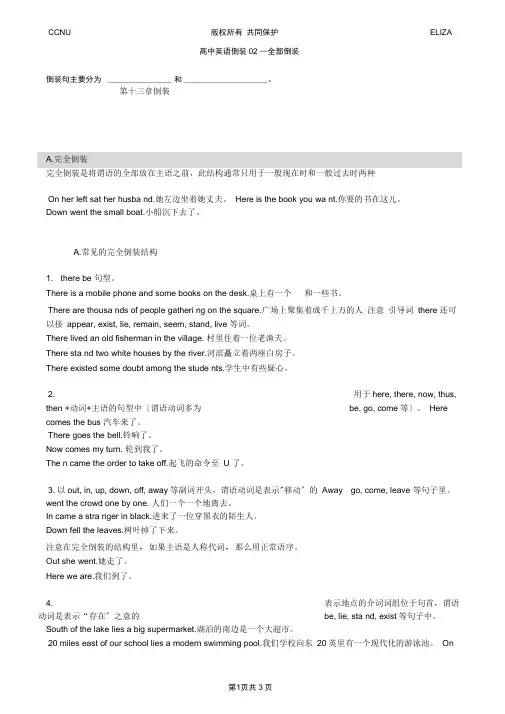
高中英语倒装02 —全部倒装倒装句主要分为________________ 和_____________________ 。
第十三章倒装完全倒装是将谓语的全部放在主语之前,此结构通常只用于一般现在时和一般过去时两种On her left sat her husba nd.她左边坐着她丈夫。
Here is the book you wa nt.你要的书在这儿。
Down went the small boat.小船沉下去了。
A.常见的完全倒装结构1. there be 句型。
There is a mobile phone and some books on the desk.桌上有一个和一些书。
There are thousa nds of people gatheri ng on the square.广场上聚集着成千上万的人注意引导词there 还可以接appear, exist, lie, remain, seem, stand, live 等词。
There lived an old fisherman in the village. 村里住着一位老渔夫。
There sta nd two white houses by the river.河滨矗立着两座白房子。
There existed some doubt among the stude nts.学生中有些疑心。
2. 用于here, there, now, thus, then +动词+主语的句型中〔谓语动词多为be, go, come等〕。
Here comes the bus 汽车来了。
There goes the bell.铃响了。
Now comes my turn. 轮到我了。
The n came the order to take off.起飞的命令至U 了。
3. 以out, in, up, down, off, away等副词开头,谓语动词是表示"移动〞的Awaygo, come, leave 等句子里。
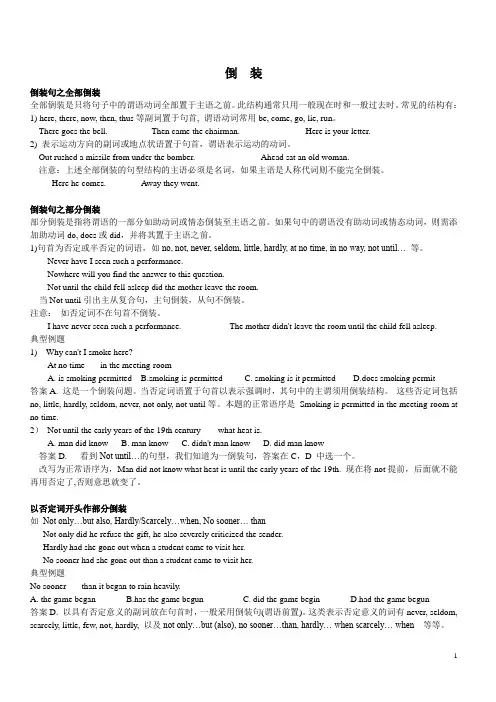
倒装倒装句之全部倒装全部倒装是只将句子中的谓语动词全部置于主语之前。
此结构通常只用一般现在时和一般过去时。
常见的结构有:1) here, there, now, then, thus等副词置于句首, 谓语动词常用be, come, go, lie, run。
There goes the bell. Then came the chairman. Here is your letter.2) 表示运动方向的副词或地点状语置于句首,谓语表示运动的动词。
Out rushed a missile from under the bomber. Ahead sat an old woman.注意:上述全部倒装的句型结构的主语必须是名词,如果主语是人称代词则不能完全倒装。
Here he comes.Away they went.倒装句之部分倒装部分倒装是指将谓语的一部分如助动词或情态倒装至主语之前。
如果句中的谓语没有助动词或情态动词,则需添加助动词do, does或did,并将其置于主语之前。
1)句首为否定或半否定的词语,如no, not, never, seldom, little, hardly, at no time, in no way, not until… 等。
Never have I seen such a performance.Nowhere will you find the answer to this question.Not until the child fell asleep did the mother leave the room.当Not until引出主从复合句,主句倒装,从句不倒装。
注意:如否定词不在句首不倒装。
I have never seen such a performance. The mother didn't leave the room until the child fell asleep.典型例题1)Why can't I smoke here?At no time___ in the meeting-roomA. is smoking permittedB.smoking is permittedC. smoking is it permittedD.does smoking permit答案A. 这是一个倒装问题。
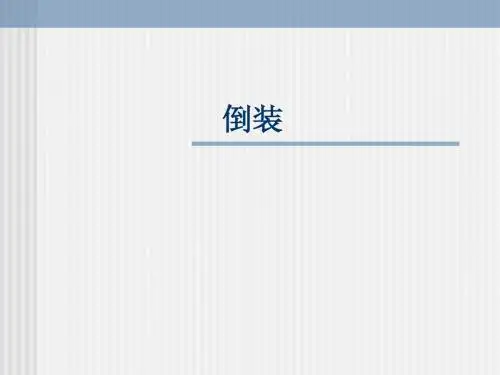
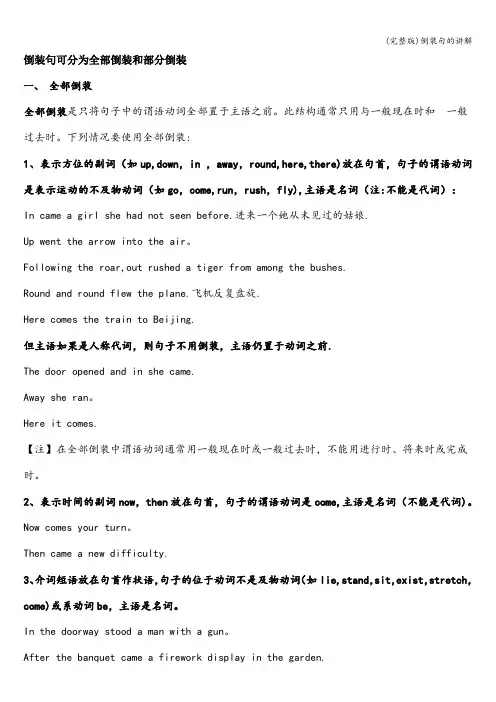
倒装句可分为全部倒装和部分倒装一、全部倒装全部倒装是只将句子中的谓语动词全部置于主语之前。
此结构通常只用与一般现在时和一般过去时。
下列情况要使用全部倒装:1、表示方位的副词(如up,down,in ,away,round,here,there)放在句首,句子的谓语动词是表示运动的不及物动词(如go,come,run,rush,fly),主语是名词(注:不能是代词):In came a girl she had not seen before.进来一个她从未见过的姑娘.Up went the arrow into the air。
Following the roar,out rushed a tiger from among the bushes.Round and round flew the plane.飞机反复盘旋.Here comes the train to Beijing.但主语如果是人称代词,则句子不用倒装,主语仍置于动词之前.The door opened and in she came.Away she ran。
Here it comes.【注】在全部倒装中谓语动词通常用一般现在时或一般过去时,不能用进行时、将来时或完成时。
2、表示时间的副词now,then放在句首,句子的谓语动词是come,主语是名词(不能是代词)。
Now comes your turn。
Then came a new difficulty.3、介词短语放在句首作状语,句子的位于动词不是及物动词(如lie,stand,sit,exist,stretch,come)或系动词be,主语是名词。
In the doorway stood a man with a gun。
After the banquet came a firework display in the garden.On the moon, as is known to all,exists no living thing。
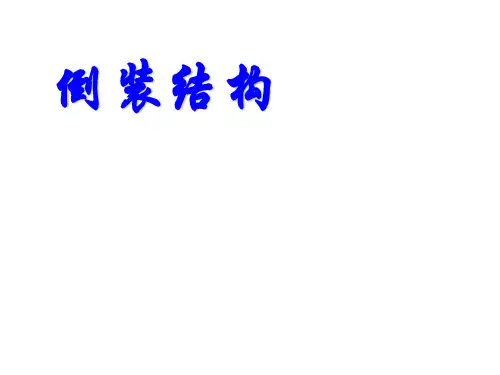
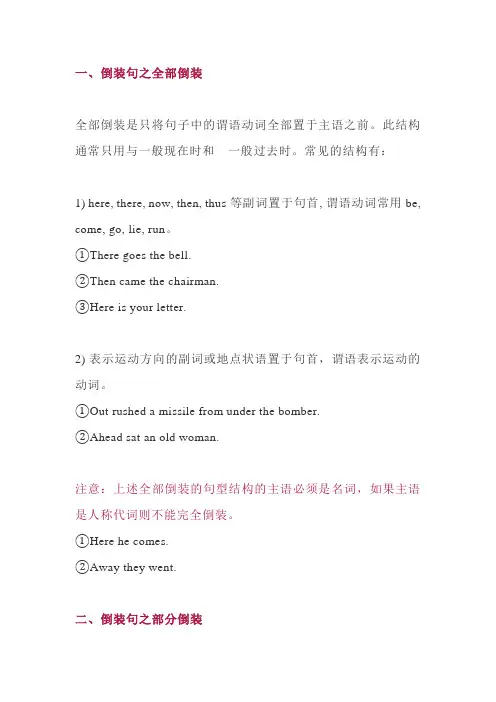
一、倒装句之全部倒装全部倒装是只将句子中的谓语动词全部置于主语之前。
此结构通常只用与一般现在时和一般过去时。
常见的结构有:1) here, there, now, then, thus等副词置于句首, 谓语动词常用be, come, go, lie, run。
①There goes the bell.②Then came the chairman.③Here is your letter.2) 表示运动方向的副词或地点状语置于句首,谓语表示运动的动词。
①Out rushed a missile from under the bomber.②Ahead sat an old woman.注意:上述全部倒装的句型结构的主语必须是名词,如果主语是人称代词则不能完全倒装。
①Here he comes.②Away they went.二、倒装句之部分倒装部分倒装是指将谓语的一部分如助动词或情态倒装至主语之前。
如果句中的谓语没有助动词或情态动词,则需添加助动词do, does或did,并将其置于主语之前。
1)句首为否定或半否定的词语,如no, not, never, seldom, little, hardly, at no time, in no way, not until…等。
①Never have I seen such a performance.②Nowhere will you find the answer to this question.③Not until the child fell asleep did the mother leave the room.当Not until引出主从复合句,主句倒装,从句不倒装。
注意:如否定词不在句首不倒装。
①I have never seen such a performance.②The mother didn't leave the room until the child fell asleep.典型例题1)Why can't I smoke here?At no time___ in the meeting-roomA. is smoking permittedB.smoking is permittedC. smoking is it permittedD.does smoking permit答案A. 这是一个倒装问题。

关于倒装句的英语语法解析倒装句是英语语法中的一种,常用语书面结构,下面就是我给大家带来的关于倒装句的英语语法解析,盼望能关心到大家!倒装句之全部倒装全部倒装是只将(句子)中的谓语动词全部置于主语之前。
此结构通常只用与一般现在时和一般过去时。
常见的结构有:1)here, there, now, then, thus等副词置于句首,谓语动词常用be, come, go, lie, run。
There goes the bell.Then came the chairman.Here is your letter.2)表示运动方向的副词或地点状语置于句首,谓语表示运动的动词。
Out rushed a missile from under the bomber.Ahead sat an old woman.留意:上述全部倒装的句型结构的主语必需是名词,假如主语是人称代词则不能完全倒装。
Here he comes.Away they went.14.2 倒装句之部分倒装部分倒装是指将谓语的一部分如助动词或情态倒装至主语之前。
假如句中的谓语没有助动词或情态动词,则需添加助动词do, does或did,并将其置于主语之前。
1)句首为否定或半否定的词语,如no, not, never, seldom, little, hardly, at no time, in no way, not until 等。
Never have I seen such a performance.Nowhere will you find the answer to this question.Not until the child fell asleep did the mother leave the room.当Not until引出主从复合句,主句倒装,从句不倒装。
留意:如否定词不在句首不倒装。
I have never seen such a performance.The mother didnt leave the room until the child fell asleep.典型例题1)Why cant I smoke here?At no time___ in the meeting-roomA. is smoking permittedB.smoking is permittedC. smoking is it permittedD.does smoking permit答案A. 这是一个倒装问题。
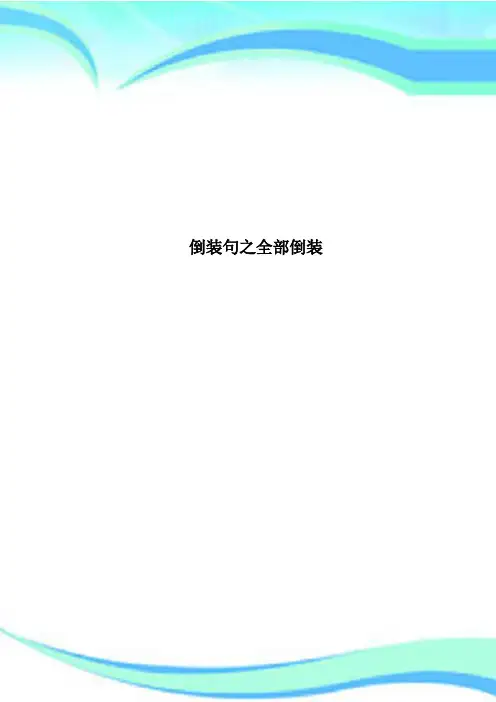
倒装句之全部倒装————————————————————————————————作者: ————————————————————————————————日期:倒装句倒装句之全部倒装全部倒装是只将句子中的谓语动词全部置于主语之前。
此结构通常只用与一般现在时和一般过去时。
常见的结构有:1)here, there,now, then, thus等副词置于句首, 谓语动词常用be,come, go, lie, run。
There goes thebell.Then came thechairman.Here isyourletter.2) 表示运动方向的副词或地点状语置于句首,谓语表示运动的动词。
Outrushed a missile fromunder the bomber.Aheadsatanoldwoman.注意:上述全部倒装的句型结构的主语必须是名词,如果主语是人称代词则不能完全倒装。
Here he comes. Awaythey went.倒装句之部分倒装部分倒装是指将谓语的一部分如助动词或情态倒装至主语之前。
如果句中的谓语没有助动词或情态动词,则需添加助动词do, does或did,并将其置于主语之前。
1) 句首为否定或半否定的词语,如no, not,never,seldom,little,hardly,atno time, in no way,not until… 等。
Never haveI seen such a performance.Nowherewillyou find the answer to this question. Not until the child fellasleepdid the motherleave theroom.当Notuntil引出主从复合句,主句倒装,从句不倒装。
注意: 如否定词不在句首不倒装。
I have never seen sucha performance.The mother didn't leavethe room untilthe child fellasleep.典型例题1) Why can't I smoke here?At notime___ inthe meeting-roomA.is smoking permitted B. smoking ispermittedC. smoking is itpermittedD.does smoking permit答案A. 这是一个倒装问题。
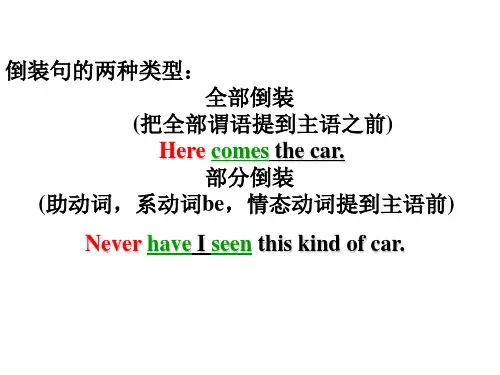

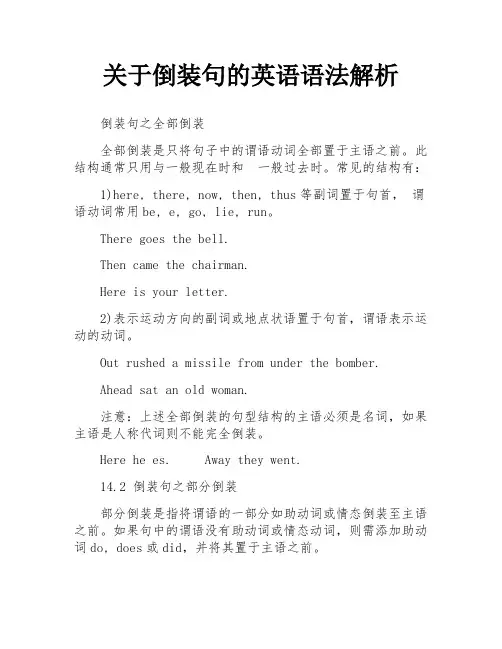
关于倒装句的英语语法解析倒装句之全部倒装全部倒装是只将句子中的谓语动词全部置于主语之前。
此结构通常只用与一般现在时和一般过去时。
常见的结构有:1)here, there, now, then, thus等副词置于句首,谓语动词常用be, e, go, lie, run。
There goes the bell.Then came the chairman.Here is your letter.2)表示运动方向的副词或地点状语置于句首,谓语表示运动的动词。
Out rushed a missile from under the bomber.Ahead sat an old woman.注意:上述全部倒装的句型结构的主语必须是名词,如果主语是人称代词则不能完全倒装。
Here he es. Away they went.14.2 倒装句之部分倒装部分倒装是指将谓语的一部分如助动词或情态倒装至主语之前。
如果句中的谓语没有助动词或情态动词,则需添加助动词do, does或did,并将其置于主语之前。
1)句首为否定或半否定的词语,如no, not, never, seldom, little, hardly, at no time, in no way, not until… 等。
Never have I seen such a performance.Nowhere will you find the answer to this question.Not until the child fell asleep did the mother leave the room.当Not until引出主从复合句,主句倒装,从句不倒装。
注意:如否定词不在句首不倒装。
I have never seen such a performance.The mother didn't leave the room until the child fell asleep.典型例题1)Why can't I smoke here?At no time___ in the meeting-roomA. is smoking permittedB.smoking is permittedC. smoking is it permittedD.does smoking permit答案A. 这是一个倒装问题。
英语中全倒装句子一、全部倒装(一)there be句型有时一些表示存在意义的不及物动词也可用于该句型,如:stand,lie,exist,live, remain,appear,come,happen,occur,rise等。
例句:Generally, there was a belief that the new nations should be sovereign and independent states, large enough to be economically viable and integrated by a common set of laws. (选自2007年Use of English)分析:该句是复合句,其中a belief与that the new nations should be sovereign and independent states互为同位语关系,形容词短语large enough to be...作定语修饰states。
译文:他们普遍认为新生的国家是拥有主权和完全独立的国家,大到经济上可运行良好,并由一套共同法律让各个新的独立国家联合起来。
(二)表示方向、地点的状语等词置于句首here, there, up, down, away, in, out, off等位于句首时,往往主谓倒装。
例句: Here is an example, which I heard at a nurses convention, of a story which works well because the audience all shared the same view of doctors.(选自2002年Text 1)分析:该句是复合句,which I heard at a nurses convention和which works well共同修饰story。
高中英语语法倒装句谓语或谓语的一部分放在主语之前的语法现象,就称之为倒装。
从倒装的形式来看,可分为完全倒装和部分倒装两大类。
前者是指整个谓语置于主语之前,而而后者仅指助动词、情态动词或be动词等置于主语之前。
一. 完全倒装完全倒装又可称为全部倒装。
完全倒装是只将句子中的谓语动词全部置于主语之前。
此结构通常只用于一般现在时和一般过去时。
常见的结构有:(1)here,there,now,then,thus等副词置于句首,谓语动词常用be,come,go,lie,run等表示来去或状态的动词。
例如:Then came the teacher. 那时老师来了。
Here is your letter. 你的信。
(2)表示运动方向的副词或地点状语置于句首,谓语表示运动的动词。
例如:Ahead sat an old woman. 前面坐着一个老大妈。
注意:上述全部倒装句型结构的主语必须是名词,如果主语是人称代词则不能完全倒装。
例如:Here he comes. 他来了。
Away they went. 他们走开了。
二. 部分倒装部分倒装是指将谓语的一部分如助动词或情态倒装放到主语之前。
如果句子的谓语没有助动词或情态动词,则需添加助动词do,does 或did,并将其置于主语之前。
(1)句首为否定或半否定的词语,如no, not, never, seldom, little, hardly, at no time, in no way, not until…等。
例如:Never have I seen such a performance.从未见过如此糟糕的表演。
Nowhere will you find the answer to this question.无论如何你不会找到这个问题的答案的。
Not until the child fell asleep did the mother leave the room.母亲一直到孩子入睡后才离开房间。
倒装【知识简介】一般陈述句结构为“主语+谓语”,如果将句子某一部分移到句子前面而引起主语和谓语的顺序颠倒就成了倒装。
疑问句一般均为倒装,但我们这里将不予讨论。
倒装有两种情况:全部倒装(提前部分+谓语动词+主语)和部分倒装(提前部分+助动词/be动词/情态动词+主语)。
【要点难点】1. 全部倒装①here, there, now, then等副词置于句首时用全倒装形式,这种句型常用来强调或提醒一个正在进行的动作,但谓语动词多为一般现在时形式(有时也用一般过去时)。
Here are the tools. 工具在这儿。
Now comes your turn. 现在轮到你了。
There goes the bell. 铃响了。
There entered a strange little man. 走进来一个奇怪而身村又矮小的人。
Once there lived an old fisherman in a village by the sea. 从前,海边的一个村子里住着一位老渔夫。
Then came Mary and George. 然后玛丽和乔治来了。
注意:如果主语为人称代词,则主谓不能倒装。
—Where’s my dictionary? 我的词典在哪里?—Here it is. 给。
(不说Here is it.)②表示位置或时间的副词如away, up, down, in, out, next, soon等,句子用全倒装形式。
在这种句型中,谓语动词往往是be动词及come, go, fall, fly, lie等趋向动词。
Down came the rain. 下雨了。
Up went the arrow into the air. 飕地一声,箭射上了天。
Away went the boy to the school! 那男孩子到学校里去了!In came our English teacher, with a dictionary in his hand. 英语老师走了进来,手里拿着本词典。
倒装句倒装句之全部倒装全部倒装是只将句子中的谓语动词全部置于主语之前。
此结构通常只用与一般现在时和一般过去时。
常见的结构有:1) here, there, now, then, thus等副词置于句首, 谓语动词常用be, come, go, lie, run。
There goes the bell.Then came the chairman.Here is your letter.2) 表示运动方向的副词或地点状语置于句首,谓语表示运动的动词。
Out rushed a missile from under the bomber.Ahead sat an old woman.注意:上述全部倒装的句型结构的主语必须是名词,如果主语是人称代词则不能完全倒装。
Here he comes. Away they went.倒装句之部分倒装部分倒装是指将谓语的一部分如助动词或情态倒装至主语之前。
如果句中的谓语没有助动词或情态动词,则需添加助动词do, does或did,并将其置于主语之前。
1) 句首为否定或半否定的词语,如no, not, never, seldom, little, hardly, at no time, in no way, not until… 等。
Never have I seen such a performance.Nowhere will you find the answer to this question.Not until the child fell asleep did the mother leave the room.当Not until引出主从复合句,主句倒装,从句不倒装。
注意:如否定词不在句首不倒装。
I have never seen such a performance.The mother didn't leave the room until the child fell asleep.典型例题1) Why can't I smoke hereAt no time___ in the meeting-roomA. is smoking permittedB. smoking is permittedC. smoking is it permittedD. does smoking permit答案A. 这是一个倒装问题。
当否定词语置于句首以表示强调时,其句中的主谓须用倒装结构。
这些否定词包括no, little, hardly, seldom, never, not only, not until 等。
本题的正常语序是Smoking is permitted in the meeting-room at no time.2)Not until the early years of the 19th century ___ what heat is.A. man did knowB. man knowC. didn't man knowD. did man know答案D. 看到Not until…的句型,我们知道为一倒装句,答案在C,D 中选一个。
改写为正常语序为,Man did not know what heat is until the early years of the19th. 现在将not提前,后面就不能再用否定了,否则意思就变了。
以否定词开头作部分倒装如Not only…but also, Hardly/Scarcely…when, No sooner… thanNot only did he refuse the gift, he also severely criticized the sender.Hardly had she gone out when a student came to visit her.No sooner had she gone out than a student came to visit her.典型例题No sooner___ than it began to rain heavily.A. the game beganB. has the game begunC. did the game beginD. had the game begun答案D. 以具有否定意义的副词放在句首时,一般采用倒装句(谓语前置)。
这类表示否定意义的词有never, seldom, scarcely, little, few, not, hardly, 以及not only…but (also), no sooner…than, hardly… when scarcely… when 等等。
注意:只有当Not only… but also连接两个分句时,才在第一个分句用倒装结构。
如果置于句首的Not only… but also仅连接两个并列词语,不可用倒装结构。
Not only you but also I am fond of music.so, neither, nor作部分倒装表示"也"、"也不" 的句子要部分倒装。
Tom can speak French. So can Jack.If you won't go, neither will I.典型例题---Do you know Jim quarrelled with his brother---I don't know, _____.A. nor don't I careB. nor do I careC. I don't care neitherD. I don't care also答案:B. nor为增补意思"也不关心",因此句子应倒装。
A错在用don't 再次否定, C neither 用法不对且缺乏连词。
D缺乏连词。
注意:当so引出的句子用以对上文内容加以证实或肯定时,不可用倒装结构。
意为"的确如此"。
Tom asked me to go to play football and so I did.---It's raining hard. ---So it is.only在句首要倒装的情况Only in this way, can you learn English well.Only after being asked three times did he come to the meeting.如果句子为主从复合句,则主句倒装,从句不倒装Only when he is seriously ill, does he ever stay in bed.as, though 引导的倒装句as / though引导的让步从句必须将表语或状语提前(形容词, 副词, 分词, 实义动词提前)。
注意:1) 句首名词不能带任何冠词。
2) 句首是实义动词, 其他助动词放在主语后。
如果实义动词有宾语和状语, 随实义动词一起放在主语之前。
Try hard as he will, he never seems able to do the work satisfactorily.注意:让步状语从句中,有though,although时,后面的主句不能有but,但是though 和yet可连用。
其他部分倒装1) so… that 句型中的so 位于句首时,需倒装。
So frightened was he that he did not dare to move an inch.2) 在某些表示祝愿的句型中:May you all be happy.3) 在虚拟语气条件句中从句谓语动词有were, had, should等词,可将if 省略,把were, had, should 移到主语之前,采取部分倒装。
Were I you, I would try it again.典型例题:1)Not until the early years of the 19th century___ what heat isA. man did knowB. man knewC. didn't man knowD. did man know答案为D. 否定词Not在句首,要求用部分倒装的句子结构。
2)Not until I began to work ___ how much time I had wasted.A. didn't I realizeB. did I realizeC. I didn't realizeD. I realize答案为B。
3) Do you know Tom bought a new carI don't know, ___.A. nor don't I careB. nor do I careC. I don't care neitherD. I don't care also解析:答案为B. 句中的nor引出部分倒装结构,表示"也不"。
由so, neither, nor 引导的倒装句,表示前一情况的重复出现。
其中, so用于肯定句, 而neither, nor 用在否定句中。
中文和英文都有主动语态、被动语态的语法。
比如你的题目中三个句子,1、3是被动态,2是主动态。
中文中的被动语态不一定需要必须说出“被”字,主要看句子结构,放在句子前面的主语结构是动作的实施对象,就是被动语态。
你的问题补充中,“你吃了吗”是省略了“饭”这个实施对象,改成被动语态的时候,不能省略这个对象,所以要改成“饭吃了吗”。
还有一个,“病被治好了吗”实际上也是省略了实施主体的,就是治病的“医生”,所以改成主动语态的时候不能省略这个主体,要改成“医生治好你的病了吗”。
所以,主动、被动语态,最主要的就是要看我们强调的是哪个方面,如果强调的是动作的实施主体,就用主动语态,于是实施的对象就无关紧要了;如果强调的是动作实施的对象,就用被动语态,这时实施的主体就可有可无了。
主动语态指主语是谓语动作的使动方。
也就是说谓语的动作源自主语,而施加于宾语。
相反,被动语态中,主语是谓语动作的受动方,如果有宾语的,宾语往往是谓语动作的使动方。
在语法机构上,主动语态和被动语态的区别主要在于,主动语态直接使用动词原形作为谓语,然后再在该动词原形的基础上施加时态和其他语法;而被动语态则使用系词+动词的过去分词作为谓语,各种时态和其他语法也施加在系词上。